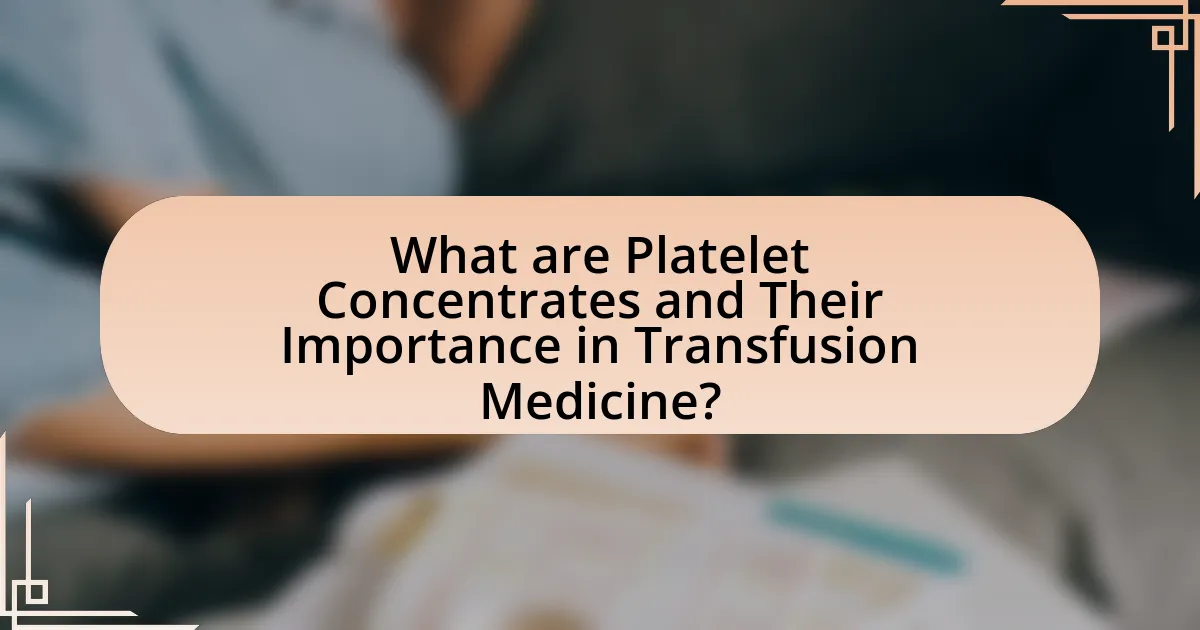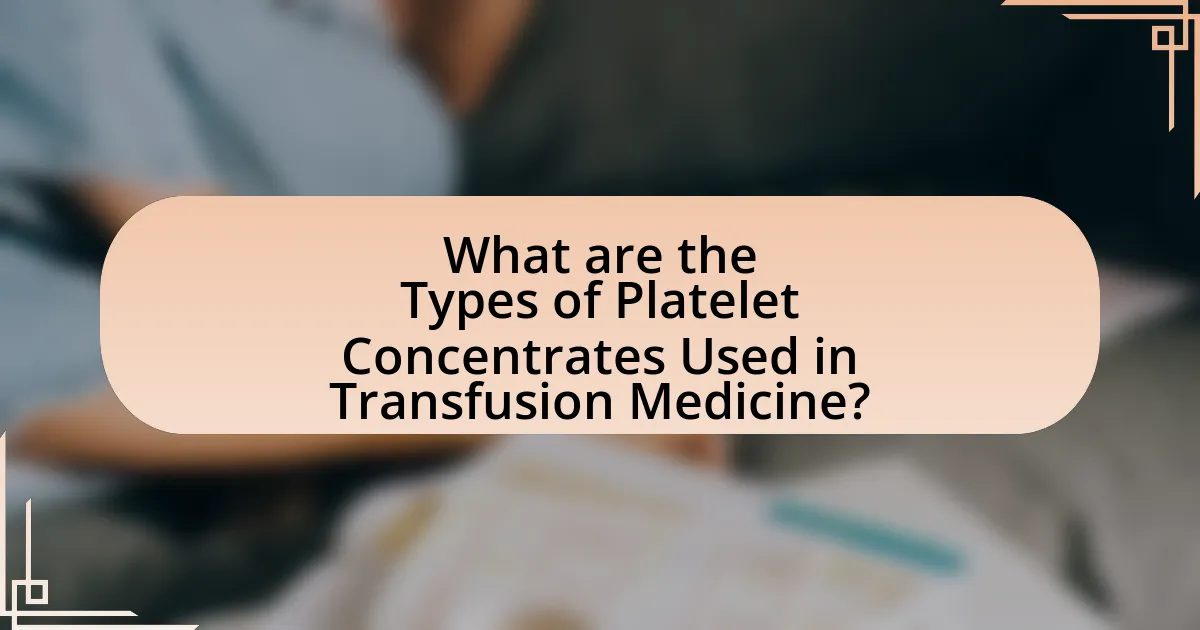Platelet concentrates are specialized blood products crucial in transfusion medicine, primarily used to treat patients with thrombocytopenia, a condition characterized by low platelet counts. This article explores the production methods of platelet concentrates, including apheresis and centrifugation, and highlights their significance in clinical settings for managing bleeding disorders and supporting surgical patients. It also addresses the role of blood donors, the types of platelet concentrates available, and the challenges associated with their use, such as storage conditions and potential transfusion reactions. Additionally, the article discusses regulatory guidelines that ensure the safety and efficacy of platelet transfusions, as well as best practices for clinicians in administering these vital products.
What are Platelet Concentrates and Their Importance in Transfusion Medicine?

Platelet concentrates are blood products derived from whole blood or apheresis that contain a high concentration of platelets, essential for blood clotting and wound healing. Their importance in transfusion medicine lies in their ability to treat patients with thrombocytopenia, a condition characterized by low platelet counts, which can result from various medical conditions such as leukemia or chemotherapy. Platelet transfusions can significantly reduce the risk of bleeding in these patients, improving their clinical outcomes. According to the American Association of Blood Banks, platelet transfusions are critical in managing patients undergoing surgery or those with hematological disorders, highlighting their vital role in modern medical practices.
How are Platelet Concentrates produced?
Platelet concentrates are produced through a process called plateletpheresis or by centrifugation of whole blood. In plateletpheresis, a donor’s blood is drawn, and a machine separates the platelets from other blood components, returning the red blood cells and plasma to the donor. This method yields a higher concentration of platelets compared to traditional methods. Alternatively, when using centrifugation, whole blood is collected and spun in a centrifuge, which separates the blood into its components; the platelet-rich plasma is then extracted and further processed to concentrate the platelets. This process is validated by the fact that platelet concentrates can contain up to five times the normal platelet count, making them effective for transfusion in patients with low platelet levels.
What are the different methods of platelet concentrate preparation?
The different methods of platelet concentrate preparation include centrifugation, apheresis, and buffy coat extraction. Centrifugation involves spinning whole blood at high speeds to separate components based on density, allowing for the collection of platelet-rich plasma. Apheresis is a process where blood is drawn from a donor, and platelets are selectively separated and collected while the remaining blood components are returned to the donor. Buffy coat extraction involves isolating the layer of white blood cells and platelets from a centrifuged blood sample, which can then be processed to concentrate the platelets. These methods are validated by their widespread use in clinical settings for producing platelet concentrates for transfusion.
What role do blood donors play in the production of platelet concentrates?
Blood donors are essential for the production of platelet concentrates, as they provide the raw material needed for this process. Platelet concentrates are derived from whole blood donations or through apheresis, where blood donors specifically donate platelets. The collected platelets are then processed and stored for use in medical treatments, particularly for patients with conditions that lead to low platelet counts, such as cancer or severe trauma. According to the American Red Cross, a single donation can yield enough platelets to help multiple patients, highlighting the critical role of blood donors in ensuring an adequate supply of this vital component in transfusion medicine.
Why are Platelet Concentrates critical in clinical settings?
Platelet concentrates are critical in clinical settings because they are essential for managing bleeding disorders and supporting patients undergoing surgeries or treatments that affect blood clotting. These concentrates provide a concentrated source of platelets, which are vital for hemostasis, the process that prevents and stops bleeding. Clinical studies have shown that platelet transfusions significantly reduce bleeding complications in patients with thrombocytopenia, a condition characterized by low platelet counts. For instance, a study published in the Journal of Thrombosis and Haemostasis demonstrated that patients receiving platelet concentrates had a marked improvement in bleeding outcomes compared to those who did not receive them. This underscores the importance of platelet concentrates in enhancing patient safety and treatment efficacy in various medical scenarios.
What conditions necessitate the use of platelet concentrates?
Platelet concentrates are necessitated in conditions characterized by thrombocytopenia or platelet dysfunction. These conditions include acute leukemia, aplastic anemia, myelodysplastic syndromes, and severe trauma or surgical procedures where significant blood loss occurs. The use of platelet concentrates is critical in these scenarios to prevent or treat bleeding complications, as they provide a concentrated source of platelets that can enhance hemostasis. Studies indicate that transfusion of platelet concentrates can significantly reduce the risk of bleeding in patients with low platelet counts, thereby supporting their essential role in modern transfusion medicine.
How do platelet concentrates improve patient outcomes?
Platelet concentrates improve patient outcomes by enhancing wound healing and reducing bleeding complications. These concentrates contain a high concentration of platelets, which release growth factors and cytokines that promote tissue repair and regeneration. Clinical studies have shown that patients receiving platelet-rich plasma (PRP) therapy experience faster recovery times and improved healing rates in various conditions, such as orthopedic injuries and surgical wounds. For instance, a systematic review published in the Journal of Orthopaedic Surgery and Research found that PRP significantly improved functional outcomes and reduced pain in patients undergoing surgery for rotator cuff tears.
What are the Types of Platelet Concentrates Used in Transfusion Medicine?

The types of platelet concentrates used in transfusion medicine include platelet-rich plasma (PRP), platelet concentrates derived from whole blood, and apheresis platelets. PRP is obtained by centrifuging whole blood to separate the platelets from other blood components, while platelet concentrates from whole blood involve collecting blood and separating platelets through a process called buffy coat preparation. Apheresis platelets are collected directly from a donor using a machine that separates and collects platelets, allowing for higher yields and reduced donor exposure. Each type serves specific clinical needs, ensuring effective treatment for patients requiring platelet transfusions.
What are the main types of platelet concentrates available?
The main types of platelet concentrates available are Platelet-Rich Plasma (PRP) and Platelet-Rich Fibrin (PRF). PRP is a concentration of platelets in plasma that is used for various medical and aesthetic applications, while PRF is a more advanced form that includes a fibrin matrix, promoting healing and tissue regeneration. Both types are derived from whole blood through centrifugation, which separates the components based on density, ensuring a high concentration of platelets for therapeutic use.
How do pooled platelet concentrates differ from single-donor platelet concentrates?
Pooled platelet concentrates are derived from multiple donors, while single-donor platelet concentrates are collected from one individual. Pooled concentrates typically contain a higher volume of platelets, as they combine the contributions from several donors, which can enhance the overall platelet count and availability for transfusion. In contrast, single-donor concentrates, often collected through apheresis, provide a more consistent and controlled platelet product, reducing the risk of transfusion reactions associated with multiple donor exposures. This distinction is crucial in transfusion medicine, as it influences both the efficacy and safety of platelet transfusions.
What are the advantages and disadvantages of each type?
The advantages of platelet concentrates include improved hemostatic function, as they provide a concentrated source of platelets that can effectively control bleeding in patients with thrombocytopenia. Additionally, they can be stored for up to five days, allowing for flexibility in transfusion timing. However, disadvantages include the risk of transfusion-related reactions and the potential for bacterial contamination, which can lead to serious complications. Furthermore, the production of platelet concentrates can be resource-intensive, requiring specialized facilities and trained personnel.
How are Platelet Concentrates stored and transported?
Platelet concentrates are stored at room temperature, typically between 20°C to 24°C, and must be gently agitated to maintain platelet viability. During transportation, they are also kept at this temperature range to prevent activation and ensure functionality. Studies indicate that maintaining this specific temperature is crucial, as storage at lower temperatures can lead to decreased platelet function and viability.
What are the optimal storage conditions for platelet concentrates?
The optimal storage conditions for platelet concentrates are at a temperature of 20 to 24 degrees Celsius with continuous gentle agitation. This temperature range is crucial because it helps maintain platelet viability and function, which is essential for effective transfusion. Studies have shown that storing platelet concentrates outside of this temperature range can lead to a significant decrease in platelet quality and functionality, impacting patient outcomes.
How does transportation affect the viability of platelet concentrates?
Transportation significantly impacts the viability of platelet concentrates by exposing them to temperature fluctuations and physical agitation. Platelet concentrates are sensitive to temperature changes; optimal storage is between 20°C and 24°C, and deviations can lead to reduced platelet function and lifespan. Studies have shown that transportation exceeding these temperature limits can result in a decrease in platelet viability, with one study indicating that exposure to temperatures outside the recommended range for even a few hours can lead to a significant loss of platelet functionality. Additionally, physical agitation during transport can cause platelet activation and aggregation, further compromising their effectiveness for transfusion.
What are the Challenges and Considerations in Using Platelet Concentrates?

The challenges and considerations in using platelet concentrates include variability in platelet yield, storage conditions, and patient response. Variability in platelet yield can affect the efficacy of treatment, as different collection methods and donor characteristics influence the concentration of platelets obtained. Storage conditions are critical, as platelets have a limited shelf life of about five days at room temperature, which can lead to concerns about bacterial contamination and loss of functionality over time. Additionally, individual patient responses to platelet transfusions can vary due to factors such as immune reactions or underlying medical conditions, complicating the predictability of treatment outcomes. These challenges necessitate careful management and monitoring to optimize the use of platelet concentrates in clinical settings.
What are the potential risks associated with platelet transfusions?
Platelet transfusions carry several potential risks, including allergic reactions, febrile non-hemolytic transfusion reactions, and transfusion-related acute lung injury (TRALI). Allergic reactions can occur in up to 1% of transfusions, presenting as hives or anaphylaxis. Febrile non-hemolytic reactions, which are caused by the recipient’s immune response to donor white blood cells, occur in approximately 1-2% of platelet transfusions. TRALI, a serious condition characterized by acute respiratory distress, has an incidence of about 1 in 5,000 to 1 in 10,000 platelet transfusions. Additionally, there is a risk of transmission of infectious diseases, although this risk has significantly decreased due to improved screening methods.
How can transfusion reactions be minimized?
Transfusion reactions can be minimized by implementing rigorous blood typing and crossmatching protocols prior to transfusions. These protocols ensure compatibility between donor and recipient blood, significantly reducing the risk of hemolytic reactions. Additionally, using leukoreduced blood products can decrease the incidence of febrile non-hemolytic transfusion reactions, as leukoreduction removes white blood cells that can trigger immune responses. According to a study published in the Journal of Blood Transfusion, the implementation of these measures has led to a marked decrease in transfusion-related adverse events, highlighting their effectiveness in enhancing patient safety during transfusions.
What are the implications of platelet refractoriness?
Platelet refractoriness has significant implications for patient management in transfusion medicine, primarily leading to inadequate platelet responses in patients requiring transfusions. This condition often results from the development of antibodies against transfused platelets, which can complicate treatment for patients with conditions such as leukemia or those undergoing chemotherapy.
The clinical consequences include increased risk of bleeding due to insufficient platelet counts, necessitating alternative strategies such as the use of HLA-matched platelet transfusions or platelet pheresis from donors. Studies indicate that approximately 30% of patients receiving multiple platelet transfusions may develop refractoriness, highlighting the need for tailored transfusion protocols to ensure effective treatment outcomes.
How does the regulatory environment impact the use of Platelet Concentrates?
The regulatory environment significantly impacts the use of platelet concentrates by establishing guidelines that ensure their safety, efficacy, and quality. Regulatory bodies, such as the FDA in the United States and the EMA in Europe, set stringent standards for the collection, processing, and storage of platelet concentrates, which directly influence clinical practices. For instance, compliance with Good Manufacturing Practices (GMP) is mandatory, ensuring that products are consistently produced and controlled according to quality standards. Additionally, regulations dictate the labeling, testing, and reporting requirements for adverse events, which are crucial for maintaining patient safety and trust in transfusion medicine. These regulatory frameworks ultimately shape the availability and application of platelet concentrates in medical settings, ensuring that they meet the necessary safety and efficacy benchmarks for patient care.
What guidelines govern the production and use of platelet concentrates?
The production and use of platelet concentrates are governed by guidelines established by organizations such as the World Health Organization (WHO) and the American Association of Blood Banks (AABB). These guidelines ensure safety, efficacy, and quality in the handling of blood products. For instance, the AABB’s Standards for Blood Banks and Transfusion Services outlines specific protocols for the collection, processing, storage, and transfusion of platelet concentrates, emphasizing the importance of maintaining sterility and proper storage conditions to prevent contamination and degradation. Additionally, regulatory bodies like the Food and Drug Administration (FDA) in the United States enforce compliance with these guidelines to safeguard patient health and ensure that platelet concentrates meet established safety standards.
How do regulations ensure the safety and efficacy of platelet transfusions?
Regulations ensure the safety and efficacy of platelet transfusions by establishing stringent guidelines for donor selection, processing, testing, and storage. These regulations, enforced by organizations such as the Food and Drug Administration (FDA) in the United States, mandate comprehensive screening of donors to minimize the risk of transmitting infectious diseases. Additionally, the regulations require rigorous testing of platelet products for pathogens and ensure that they are processed under controlled conditions to maintain their viability and functionality. For instance, the FDA’s Code of Federal Regulations outlines specific criteria for platelet collection and storage, which helps to ensure that transfusions are both safe and effective for patients.
What are the best practices for clinicians when administering Platelet Concentrates?
The best practices for clinicians when administering Platelet Concentrates include ensuring proper patient identification, verifying the product’s compatibility, and monitoring the patient for adverse reactions. Clinicians should confirm the patient’s blood type and crossmatch results to prevent transfusion reactions. Additionally, it is essential to administer Platelet Concentrates through a dedicated blood transfusion set to minimize contamination and ensure optimal flow rates. Monitoring vital signs before, during, and after the transfusion is crucial to detect any immediate reactions. According to the American Association of Blood Banks, adherence to these practices significantly reduces the risk of complications associated with platelet transfusions.
How should clinicians assess the need for platelet transfusion?
Clinicians should assess the need for platelet transfusion by evaluating the patient’s clinical condition, platelet count, and the presence of bleeding symptoms. A platelet count below 10,000 to 20,000 platelets per microliter typically indicates a need for transfusion, especially in patients with active bleeding or undergoing invasive procedures. Additionally, the clinical context, such as the patient’s underlying condition and response to previous treatments, plays a crucial role in decision-making. Studies have shown that transfusion thresholds can vary based on individual patient factors, emphasizing the importance of a tailored approach to each case.
What monitoring protocols should be followed during and after transfusion?
During and after transfusion, monitoring protocols include assessing vital signs, observing for transfusion reactions, and evaluating the patient’s overall response to the transfusion. Specifically, vital signs should be checked before the transfusion, at 15 minutes after starting, and every hour during the transfusion, as well as 1 hour post-transfusion. This systematic approach helps identify any adverse reactions early, such as fever, chills, or allergic responses. The importance of these protocols is supported by guidelines from organizations like the American Association of Blood Banks, which emphasize the need for vigilant monitoring to ensure patient safety and effective transfusion outcomes.